Hallival and Askival Layered Intrusions
Rum, Inner Hebrides, Scotland
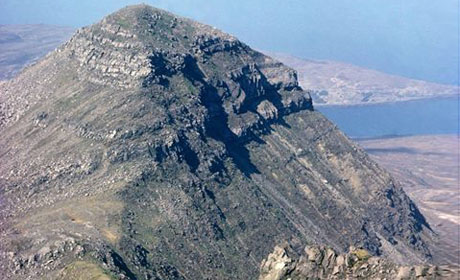
The mountainous, rugged island of Rum is the eroded remains of a volcanic centre which formed in the Palaeocene, about 58 million years ago, during a major volcanic episode that accompanied the beginning of the opening of the North Atlantic Ocean.
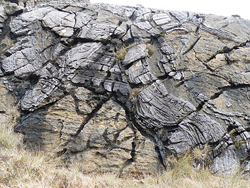 Many of the rocks found on Rum consist of layered ultramafic rocks – remnants of the base of the volcano’s magma chamber.
Many of the rocks found on Rum consist of layered ultramafic rocks – remnants of the base of the volcano’s magma chamber.
Layered igneous rocks of the same age occur in centres on Mull and Skye, accompanied by a large thickness of lavas, and also in the Ardnamurchan ring complex. What sets Rum apart, and unquestionably gives it top international status, is the variety of styles and scales of layering.
The study of frozen magma chambers
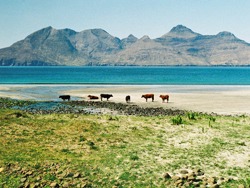
Layered igneous intrusions have a special place in the study of igneous rocks. These frozen magma chambers hold the key to many of the processes that lead to the evolution and diversity of lavas.
Many are sources of minerals vital to the modern world.The most famous have names familiar to geologists: Skaergaard, Bushveld, Stillwater, Rum…!
It is not likely that, in the foreseeable future, we shall be able to look inside one of these mighty, white-hot, pressurized chambers to observe processes directly. We have to make do with the frozen remains, and use our powers of deduction, along with some clever chemistry and physics, to explain what we see.

As with the other Scottish Palaeogene volcanic centres, Rum has been studied by many esteemed geologists.
John MacCulloch (1773 – 1835), John Wesley Judd (1879 – 1914) and Sir Archibald Geikie, were followed by more recent researchers such as Dr Alfred Harker (1859 – 1939) and Sir Edward Bailey (1881 – 1965).
Rum’s layers
The layered rocks of the Rum Central Complex are divided into three overlapping intrusions, each with its own inventory of igneous structures. The dramatic mountains of Askival and Hallival are part of the Eastern Layered Intrusion, formed mainly of inter-bedded peridotite and troctolite.
Within the units there are rhythmic and graded layers, on scales of tens of centimetres, produced by settling of crystals onto the floor of the magma chamber, sorted by crystal density. Some structures are ascribed to replacement after the crystals had accumulated. The more feldspar-rich layers were given the name ‘allivalite’.

The two mountains have distinctive steps in their skylines, visible from the Scottish mainland 16 miles to the East, which mark 16 major units averaging 50 m in thickness.
These major layers are thought to represent fresh influxes of magma into the chamber.
Evolution of the Rum Complex
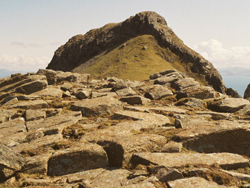
The Rum Complex was intruded into Lewisian gneiss basement, Torridonian sandstones (Precambrian), Mesozoic sedimentary rocks and early Palaeogene lavas. The complex itself evolved in two main stages.
Initially, intrusive and extrusive activity was charged by acid magmatism and associated with ring-faulting. It is thought that the complex underwent repeated doming and subsidence (within the cauldron) at this time. Rocks associated with this first phase include porphyritic felsite, volcanic breccias and tuffs.
The layered ultrabasic rocks were intruded during the second stage. The parent magma is considered to be either high-temperature picritic basalt or feldspathic peridotite that was subject to the right conditions that enabled it to rise to within a short distance of the Earth’s surface before crystallising. The intrusions consist of sixteen layers of alternating feldspathic peridotite, troctolite, troctolitic gabbro, feldspathic gabbro and anorthosite.
Aladdin’s cave of petrological wonders
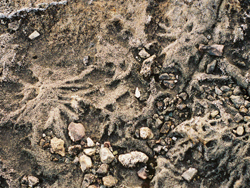 The Western Layered Intrusion is relatively small, but is strongly layered and notable for an extraordinary rock texture called ‘harrisite’, named after the locality of Harris in the west of Rum.
The Western Layered Intrusion is relatively small, but is strongly layered and notable for an extraordinary rock texture called ‘harrisite’, named after the locality of Harris in the west of Rum.
Harrisite is composed of thin, branching crystals of olivine up to 60 cm long, forming layers up to 1 m in thickness. The fragile olivine grew in place, rather as do crystals in a ‘chemical garden’, indicating extremely quiet conditions in the magma.
In contrast, the Central Layered Intrusion, which cuts across the Eastern and Western intrusions, is characterised by the development of breccias composed of huge blocks of layered troctolite and peridotite in a feldspathic peridotite matrix.

There are avalanches of peridotite ‘pebbles’ and rafts of troctolite tens of metres in extent. The Central Layered Intrusion formed in turbulent times!
The Rum intrusion is an Aladdin’s cave of petrological wonders, a unique insight into an unattainable world beneath a great volcano, a Geosite of many mysteries.
Text courtesy of Stephen Beard (Lochaber Geopark) and ScottishGeology.com
Related Links
Nearby Geosites
The North Atlantic Palaeogene Igneous Province
Images (top to bottom):
- Hallival summit from Askival © Lochaber Geopark
- Layered peridotite & troctolite on Rum © Anne Burgess (Source Geograph.org.uk) Creative Commons Attribution-ShareAlike 2.0 license.
- Rum from Eigg © Liz Mickiewicz
- Snow outlining layers on Askival © Lisa Jarvis (Source Geograph.org.uk) Creative Commons Attribution-ShareAlike 2.0 license.
- Steps in the skyline © Anne Burgess (Source Geograph.org.uk) Creative Commons Attribution-ShareAlike 2.0 license.
- Cracked peridotite on Askival ridge © Liz Mickiewicz
- Harrisite branching texture © Liz Mickiewicz
- Peridotite 'pebbles' within troctolite © Anne Burgess (Source Geograph.org.uk) Creative Commons Attribution-ShareAlike 2.0 license.

October 13 - 21
Theme: 'Earth Science in our lives'
